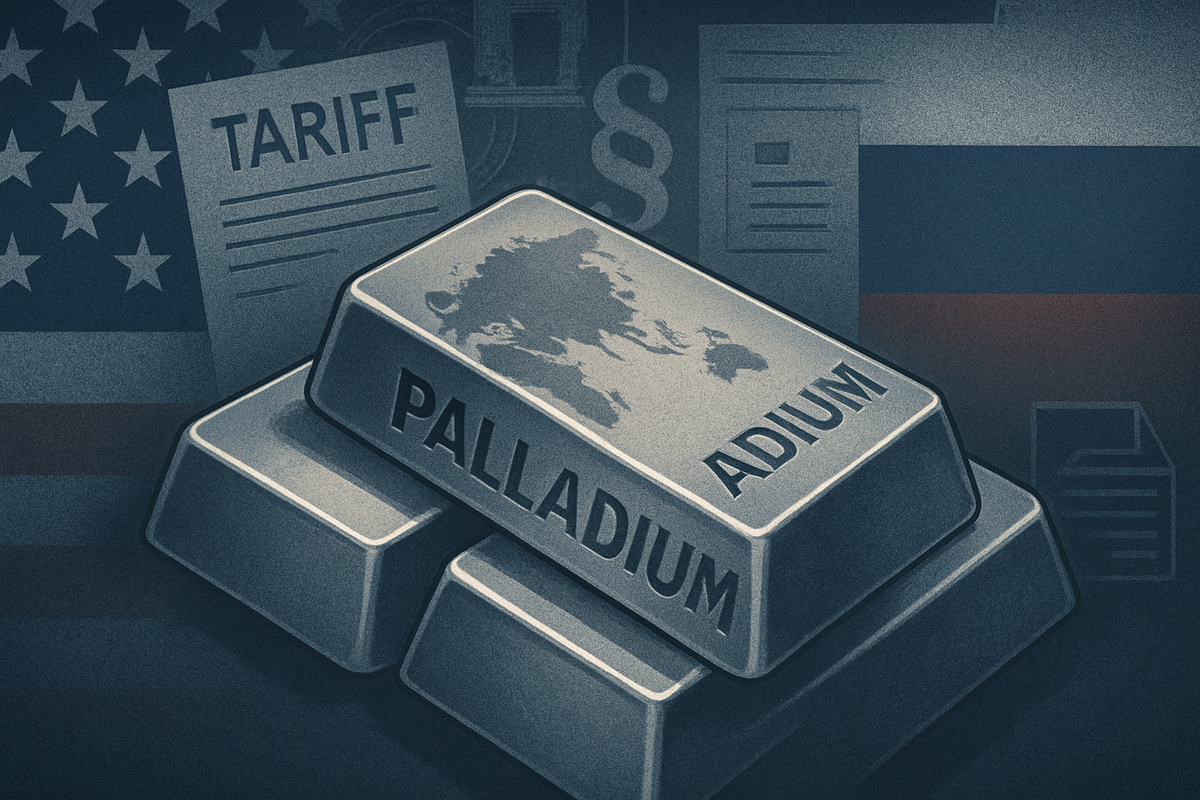
The global palladium market is currently grappling with significant uncertainty and volatility following the initiation of anti-dumping petitions and a subsequent U.S. trade investigation into Russian palladium imports. This unfolding scenario, driven by geopolitical tensions and a renewed focus on critical mineral supply chains, promises to reshape trade dynamics and pricing structures for this crucial precious metal, with immediate implications for industries worldwide.
As of October 22, 2025, the U.S. Department of Commerce and the U.S. International Trade Commission (ITC) are actively probing allegations that unwrought Russian palladium is being sold in the U.S. at less than fair value and benefiting from unfair subsidies. This investigation has already injected considerable volatility into palladium prices, which have seen a remarkable 70% year-to-date rally in 2025, underscoring the market's sensitivity to potential supply disruptions from Russia, a dominant global producer.
The Petitions That Shook the Palladium Market
The catalyst for this trade upheaval came on July 30, 2025, when a coalition of domestic producers, led by Sibanye-Stillwater (NYSE: SBSW), the sole primary platinum group metals (PGM) producer in the U.S., and the United Steelworkers union, filed comprehensive anti-dumping (AD) and countervailing duty (CVD) petitions. These petitions targeted unwrought palladium from Russia, encompassing various forms such as ingots, blocks, and powders, alleging that these imports are being sold below fair market value and are unfairly subsidized by the Russian government, causing material injury to the U.S. domestic industry.
The petitioners highlighted a substantial increase in Russian palladium imports into the U.S.—a 34% surge from 2021 to 2024, with an additional 30% rise in 2025. This influx coincided with a 27% decline in U.S. domestic mining production and a 30% drop in recycling supply during the same period. The U.S. Department of Commerce officially initiated its investigations on August 19, 2025. A pivotal moment arrived on September 12, 2025, when the ITC issued an affirmative preliminary determination, finding a "reasonable indication" that the U.S. industry is indeed being materially injured by these allegedly dumped and subsidized imports. This affirmative vote cleared the path for Commerce to proceed with its investigations, with a final determination on these cases anticipated around late August 2026. The price of palladium, which eased to around $1,392.50 per troy ounce on October 22, 2025, from a mid-October high of $1,666, reflects the ongoing uncertainty and the market's attempt to price in potential future tariffs or restrictions.
Winners and Losers in a Reshaped Market
The outcome of this investigation will undoubtedly create clear winners and losers across the global metals and automotive sectors. Norilsk Nickel (MCX:GMKN), Russia's mining giant and the world's largest palladium producer, stands to be the most significantly impacted loser. Any tariffs or trade restrictions would directly reduce its market share and revenue from the lucrative U.S. market, forcing it to potentially seek alternative buyers at discounted rates, such as China, which has reportedly increased its intake of Russian metal.
On the consumer side, automotive manufacturers like General Motors (NYSE: GM) and Ford Motor Company (NYSE: F), which rely heavily on palladium for catalytic converters (accounting for over 80% of global demand), could face increased procurement costs. While substitution with platinum is possible, retooling for this can be a costly and time-consuming endeavor in the short term. Similarly, electronics companies such as Apple (NASDAQ: AAPL), which use palladium in components like multilayer ceramic capacitors (MLCCs), could also see elevated input costs, though the automotive sector's impact would be far greater.
Conversely, non-Russian palladium producers are poised to be significant beneficiaries. Sibanye-Stillwater (NYSE: SBSW), as a petitioner and the sole U.S. primary PGM producer, stands to gain from increased demand and potentially higher prices for its palladium. Other major South African PGM producers, including Impala Platinum Holdings (OTCQX: IMPUY) and Anglo American Platinum (OTCPK: ANGPY), would also be well-positioned to capture additional market share. Smaller, developing players like Platinum Group Metals Ltd. (NYSE American: PLG, TSX: PTM) and Ivanhoe Mines (OTCQX: IVPAF), with projects in South Africa, could see enhanced project viability and investment interest. Northam Platinum (JSE: NHM), another South African miner, would also likely see increased demand for its palladium output. Furthermore, companies investing in palladium substitutes, such as ruthenium (a cheaper PGM, largely sourced from South Africa) or advanced platinum-based catalytic converter technologies, could see increased interest and demand for their innovations.
Broader Implications and Historical Context
This U.S. anti-dumping investigation on Russian palladium is not an isolated incident but rather fits into a broader global trend of re-evaluating critical mineral supply chains and addressing geopolitical risks. The classification of palladium as a critical metal in the U.S. underscores its strategic importance for industrial and clean energy goals, driving the imperative to secure resilient domestic supply. The ongoing geopolitical tensions stemming from Russia's actions in Ukraine in 2022 further amplify these concerns, with discussions around potential broader G7 sanctions on Russian palladium exports looming large, which could create a structural market deficit. The U.S. is also contemplating Section 232 tariffs on platinum group metals, including palladium, citing concentrated supply chains and high external dependency, signaling a comprehensive strategy to use trade tools to stimulate domestic manufacturing and secure vital resources.
Historically, the U.S. has frequently employed anti-dumping and countervailing duty laws to protect domestic industries. Notable precedents include trade actions against rare earth elements from China, tungsten shot from China (where the "material retardation" theory was successfully used to protect a nascent U.S. industry), and ongoing investigations into silicon metal from various countries. The U.S. steel and aluminum industries have also been frequent petitioners, with recent AD/CVD orders on aluminum foil and extrusions from multiple nations. Even copper faced a Section 232 investigation in February 2025, leading to tariffs in July 2025, demonstrating the rapid pace at which trade actions on essential metals can be implemented when national security is invoked. These precedents highlight a consistent U.S. policy to leverage trade remedies against perceived unfair practices, making the current palladium investigation a continuation of a well-established pattern.
The Road Ahead: Scenarios and Strategic Pivots
The coming months will be critical for the palladium market. The immediate focus will be on the ongoing investigations by the U.S. Department of Commerce, leading up to the final determination expected in late August 2026. Until then, expect continued price volatility as the market reacts to every development. Short-term possibilities include further price spikes if preliminary duties are imposed, or a softening if the investigation falters. Long-term, a definitive imposition of duties could fundamentally alter global palladium trade flows, creating a bifurcated market with non-Russian palladium commanding a premium in the U.S. and potentially discounted Russian supply flowing to other markets.
Companies reliant on Russian palladium will need to accelerate strategic pivots, diversifying their supply chains to secure non-Russian sources or intensifying efforts to substitute palladium with platinum or other alternatives in their products. This presents significant market opportunities for non-Russian PGM producers to expand their output and market share. Conversely, industries heavily dependent on competitively priced Russian palladium face challenges in managing increased input costs and ensuring supply security. Potential scenarios range from the imposition of significant tariffs, leading to a structural shift in the market, to a less impactful outcome if the investigations do not find sufficient evidence of dumping or subsidies causing injury. The possibility of broader G7 sanctions on Russian palladium also remains a potent wildcard that could trigger a more severe supply crunch.
A Market in Flux: What Investors Should Watch
The U.S. anti-dumping investigation on Russian palladium marks a pivotal moment for the global metal markets. It underscores the increasing intersection of trade policy, geopolitical strategy, and critical mineral supply chain security. The event highlights the vulnerability of industries reliant on concentrated sources of essential raw materials and the willingness of governments to use trade remedies to protect domestic interests.
Investors should closely monitor the progress of the U.S. Department of Commerce and ITC investigations, paying particular attention to preliminary and final duty determinations. Geopolitical developments, especially regarding potential G7 sanctions on Russian PGMs, will also be crucial market movers. Furthermore, observe technological advancements in palladium substitution, as increased costs could accelerate the adoption of platinum or ruthenium in catalytic converters. The long-term impact will likely be a more diversified and potentially higher-cost palladium market, emphasizing the importance of supply chain resilience and strategic sourcing. This event is a stark reminder that even in established commodity markets, external factors can trigger profound and lasting transformations.
This content is intended for informational purposes only and is not financial advice








